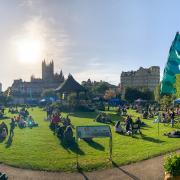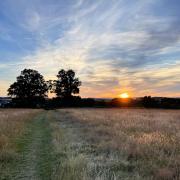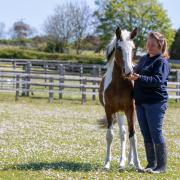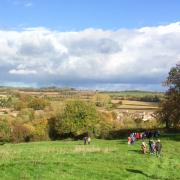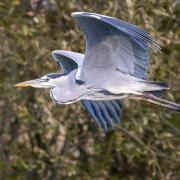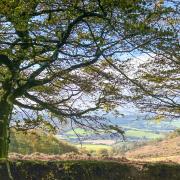Exmoor welcomes walkers to re-trace the steps of the celebrated Somerset resident and poet, Samuel Taylor Coleridge. Join Rachel Mead as she explores the 51 mile trail
Coleridge, like his friends William and Dorothy Wordsworth, was a pioneer walker – part of that group of writers, artists and thinkers who, from the late 1700’s onward, rediscovered landscape as a deep source of meaning and inspiration.’ says Tom Mayberry MBE, Chief Executive of the South West Heritage Trust. ‘For Coleridge and the Wordsworth’s, the landscapes they explored and loved in Somerset were almost a moral presence, a teacher and guide instructing them in what it meant to be truly human. The extraordinary beauty of the Coleridge Way hasn’t lost its ability to move and renew us today. It links us powerfully to Coleridge and his friends, and to what they sought so memorably to express in their writing over two centuries ago.’

With my backpack loaded for three days’ hiking, I was invited by the Visit Exmoor team to walk the 51 mile Coleridge Way, enjoying some of Exmoor’s hospitality whilst celebrating the 250th anniversary of Coleridge’s birth. I chose to start at the Lynmouth Pavilion and weaved my way eastwards across our county before finishing at Coleridge Cottage, in Nether Stowey, now owned by the National Trust. To be walking in the footsteps of such a revered poet certainly adds a whole new level of meaning to this hike and as I laced up my Gore-Tex hiking boots, I found myself wondering what Coleridge himself would have worn for such diverse terrain!
I always like to start early, so just as the sun was beginning to rise over the treetops of Wester Wood, I left the coast in my wake, and picked up the trail which runs alongside the East Lyn River. The river waters here are exceptionally clean and it’s a favoured spot for those who are keen to fish for salmon and trout, and as woodland walks go, this one is fantastically noisy with birdsong! The footpath is climbing from the off so don’t overdress, you’ll soon warm up, and as the trail leads you past farmhouses (selling cakes at the gate – remember to bring some cash!) and then opens out above Brendon, you’ll be able to look back over your shoulder and see the Bristol channel beyond. In fact, the sea is never far away as you follow the Coleridge Way, for it is always within sight when you have gained elevation, and for me, that dusky blue in combination with the mixed hues of green from the moorland, the forests and the farmers’ fields, just adds an increased depth to the landscape. It is Somerset at its very best and it is clear how Coleridge found his inspiration here.
‘A green and silent spot, amid the hills,
A small and silent dell! O’er stiller place
No singing sky-lark ever poised himself.
The hills are heathy, save that swelling slope,
What hath a gay and gorgeous covering on…’
It is perhaps reassuring for fellow walkers to know that this footpath across Exmoor still mirrors the stillness and silence which Coleridge wrote about all those years ago. We may be walking the landscape over two hundred years after Coleridge stepped out, but aside from the occasional dog walker or grazing Exmoor pony, I too have marvelled at the stillness and comfortable solitude that I have found here. The Coleridge Way is akin to a theatre performance with the most superior of set designs, the scenery is constantly changing, drawing you into the most magical of performances, of which you fortuitously have the leading role. Along your journey you will be able to picnic under ancient trees, trip trap over cobbled packhorse bridges and stride along timeworn by-ways all of which are heightened by the shifting seasonal colours.

As you progress on your travels, you will also call into some of Somerset’s finest hamlets and villages, Porlock, Monksilver, Wheddon Cross, Luxborough and Bicknoller will all greet you with countryside cottages, a village church and, if energy levels are needing recharging, refreshment in one of their local pubs. In fact, it may be prudent to plan your hiking around some of these locations. For those of you wishing to cover the route in three days I can recommend an overnight stay in the aptly-named Xanadu, a shepherd’s hut in an elevated position at Parsonage Farm near Culbone, home to the smallest church in England. It is stated that Coleridge himself stayed at a farm near to St Beuno’s so you may in-fact even be resting at the very same spot as our romantic poet!
My second night was spent at The Royal Oak in Luxborough. Greeted with a roaring log fire, cosy intimate bar and a sumptuous bed for weary legs, your full day of hiking will definitely have earned you three courses from their excellent menu, and a soak in the roll-top bath! Emma Thomasson, CEO from Visit Exmoor says, ‘The Coleridge Way inspires and delights walkers, showcasing Exmoor’s unique landscapes and some hidden treasures! It can be split into segments (head to visit-exmoor.co.uk for route guidance) or experienced over a few days, which gives the opportunity to enjoy our famous Exmoor warm welcome and hospitality in villages and settlements along the way. 2022 was Coleridge’s 250th Birthday which has been a wonderful opportunity to reflect on how inspired he and other poets, like Wordsworth were by Exmoor’s natural assets.’
It is incredible to think that Coleridge covered such mileage in the few years that he lived in Nether Stowey, very likely without the comforts to which we are accustomed. Charlotte Hall, the National Trust Visitor Experience Officer at Coleridge Cottage is pleased to welcome walkers of the Coleridge Way with a certificate as they arrive at Coleridge’s former home. ‘We always reward those who have followed in the poet’s footsteps. Coleridge was an interesting man, he started the Romantic movement with William Wordsworth in Nether Stowey and he had previously spoken out against slavery, they were both very ahead of the curve. Coleridge was brave and working for and welcoming to change, and we know that he was assisted in that work by walking, going out in the light and coming back in the dark.’

And now, beloved Stowey! I behold
Thy church-tower and, me thinks the four huge elms…
…Is my own lowly cottage, where my babe
And my babe’s mother dwell in peace! With light
And quickened footsteps thitherward I tend…’









